| Manufacturer: | Paper |
 Brief:
Brief:
This rocket was based on plans for a paper Proton launch vehicle and were available at the Classic Paper Space Models website. Unfortunately, it appears this particular website no longer exists and the plans are unavailable. I was generously provided the plans by dtomko of The Rocketry Forum. In my opinion, rocket manufacturers have overlooked Russian launch vehicles and I thought a conversion of a Proton to a flying model would be a fun challenge.
Manufactured by the Khrunichev Design Bureau, the Proton is a workhorse for the Russian space program. It was originally designed as an ICBM in the 1960's but was never deployed for that use. It continues to fly today lofting payloads for both Russian and international customers. Some famous payloads flown by Proton vehicles include the Zond probes to the moon, the Salyut series of space stations, Mir modules, and pieces of the International Space Station (ISS). The plans depict the vehicle that carried the Zvesda module to the ISS in July 2000.
For more information regarding the Proton rocket, see the International Launch Services (ILS) website for the commercial marketer of the vehicle.
Construction:
The following is a list of materials I used to build the Khrunichev Proton:
- 65 lb cardstock
- foam core
- 18 mm tube
- 13 mm tube
- screw eye
- shock cord
- shock cord mount
- streamer or parachute
- standard launch lug
- clay for nose weight
- white glue
- yellow glue
- epoxy
- masking tape
- toothpick for applying glue and for rolling small tubes
- Instructions and Patterns (3M Zip File)
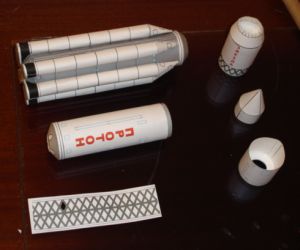
The plans come in nine separate JPG files. This allows the builder to scale the plans to any desired size. The plans provided recommend scale factors to build models of scale 1/144, 1/100, 1/96, 1/97, and 1/50. I chose to build my model at 1/144th scale because it would print on standard 8.5x11 cardstock. The plans were straightforward and adequate for assembling the model. They offer short, concise, text descriptions. There are many pictures of the various pieces and the assembly process. Anyone who has built rockets should be able to follow them without difficulty. I followed the plans with few deviations. These consisted of changing the model to handle a motor tube, recovery system, and a launch lug. White glue was used throughout except for gluing the motor tube to the centering rings with yellow glue and gluing the screw eye to a bulkhead with epoxy.
Construction began with the first stage. The Proton first stage consists of a central oxidizer tank, six external fuel tanks, six rocket engines, and an interstage. The external fuel tanks are often confused as being strap-on boosters. A hole was cut in the bottom of the central oxidizer tank to accommodate a 18mm motor tube. I chose 18mm mainly because I was unsure if I would build the model light enough to fly on 13 mm motors. With no stabilizing fins, I assumed a generous amount of modeling clay would be required to make the rocket stable. This would add weight to the model and possibly prohibit use of the smaller 13mm motors as well.
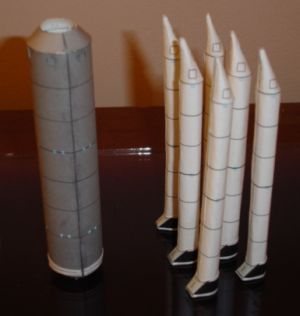 At this point I also chose to stop the 18mm tube at the top of the first stage and to carry a 13mm tube from the interstage through the third stage of the Proton. This was done to ensure that the ejection gases vented through a motor tube, as opposed to the cardstock body. I made centering rings out of foam core to center the 13mm tube within the 18mm tube. I would not recommend doing what I did. In hindsight I should have kept things simple and used a single 18mm tube throughout the rocket. In order to strengthen the model for flight, discs provided in the plans were glued to centering rings cut from foam core.
At this point I also chose to stop the 18mm tube at the top of the first stage and to carry a 13mm tube from the interstage through the third stage of the Proton. This was done to ensure that the ejection gases vented through a motor tube, as opposed to the cardstock body. I made centering rings out of foam core to center the 13mm tube within the 18mm tube. I would not recommend doing what I did. In hindsight I should have kept things simple and used a single 18mm tube throughout the rocket. In order to strengthen the model for flight, discs provided in the plans were glued to centering rings cut from foam core.
Rolling the external fuel tanks into a nice cylindrical shaped proved to be difficult for me. If I was planning to only use my model for display, ordinary printer paper might be easier to roll. Since I wanted to fly my model, I used cardstock for the added strength. Alignment of the six propellant tanks can be tricky. Mine is by no means perfect but I can live with the results.
Once the fuel tanks were glued to the oxidizer tank, I added the many small details provided in the plans. Rocket nozzles, outriggers, aeroguides, and turbopumps are just some of the intricate pieces the builder can use to add realism to the model. A standard launch lug was glued to the oxidizer tank between two of the fuel tanks. I made a standoff out of foam core to help the lug clear the model details more easily. To help the launch rod pass through the launch lug a small notch was cut in the appropriate aeroguide at the bottom of the first stage.
The second and third stage exteriors were built as specified in the plans. Since I was building a flying model the second stage was glued to the 13mm tube and the third stage was glued to the second. I omitted the rocket nozzles and cylinders on the third stage since mine was not a display model. As with the first stage, foam core centering rings were used to hold the 13mm tube. The tube ends at the bottom of the third stage. This allows the third stage and the Zvesda module to be used to hold the recovery system. A coupler was made from cardstock and glued to the Zvesda module to allow it to attach and separate from the third stage. By itself, the coupler fit too loosely on the third stage so I used masking tape to achieve the proper amount of friction. The recovery system consisted of a standard 3-fold type mount and an 18-inch shock cord glued to the inside of the third stage section. A screw eye was epoxied to a bulkhead made of foam core. The shock cord was tied to the screw eye and the bulkhead was then glued into the Zvesda module. Since there was enough room in the third stage and Zvesda module to hold it, I chose to use a 12-inch parachute for recovery. This ensures a gentle landing for the model.
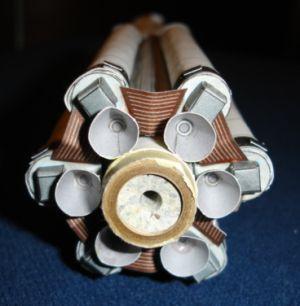 Approximately one ounce of modeling clay was added to the nose cone and upper tube of the Zvesda module--about half the empty weight of the entire model! With an Estes C6-5 installed the CG was located just above the interstage ring with a total weight of three ounces. A swing test confirmed that the vehicle was stable. Despite a successful swing test, I plan to wait and only fly this model on calm days with no wind. The overall length of the model is approximately 15 inches.
Approximately one ounce of modeling clay was added to the nose cone and upper tube of the Zvesda module--about half the empty weight of the entire model! With an Estes C6-5 installed the CG was located just above the interstage ring with a total weight of three ounces. A swing test confirmed that the vehicle was stable. Despite a successful swing test, I plan to wait and only fly this model on calm days with no wind. The overall length of the model is approximately 15 inches.
PROS:
- Fun build
- Quick construction
- Parts are easily replaced (just print more!)
- Lots of small intricate details for nice realism
CONS:
- Website to obtain the plans is gone
- Lots of small intricate details to "fat finger" if you are a clumsy builder like me
- No fins to provide stability
- Half the empty weight is nose weight
- Not much room for parachute and wadding
Finishing:
Since all the detail is printed on the paper, there is no finishing required. I added all the raceway and cabling details to the model. This proved to be time consuming but really makes the model look realistic. The one thing about paper builds is the seam left between the various parts. If this had been a conventional build, some Fill N' Finish would eliminate those seams. Parts of it are definitely rough but this can be blamed on my construction abilities as opposed to poor design.
PROS:
- No painting! No sanding! No filling!
CONS:
- Seams
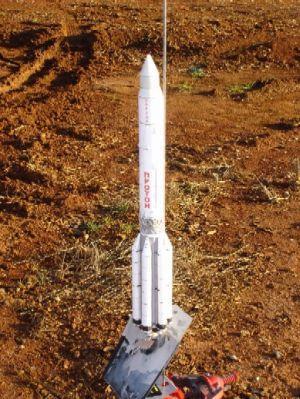
Flight:
I opted to use friction fit for the motor. A motor block was formed from a section of used 18mm motor and gluing it into the motor tube. I used a 12" chute for recovery and cellulose for recovery wadding. There is not much room to pack a chute into this rocket the way I built it.
Launch day finally came but unfortunately all the nice grassy fields I could fly from were packed with model airplanes or soccer players, so I went roughing it. I have a tendency for "go fever" so I went to a just recently tilled cotton field. It made for a less than ideal surface, but I was sick of looking at this model sitting on the shelf and wondering if it was really stable. The only way to know for sure was to fly.
An Estes B6-2 was chosen because I didn't want too much altitude, but wanted to make sure there was adequate initial thrust for stable flight once the launch rod was cleared. The Two second delay chosen because I would rather err short instead of long. If it turned out to be an unstable flight, I wanted the chute to get deployed as quickly as possible.
Flight 1: After a nervous countdown the Proton took to the air. The initial trajectory was straight but as the vehicle approached burnout a noticeable precession began. Nothing severe, but it was noticeable. The two-second delay proved to be early as expected. The parachute ejected normally and the rocket descended to the tilled clay. .
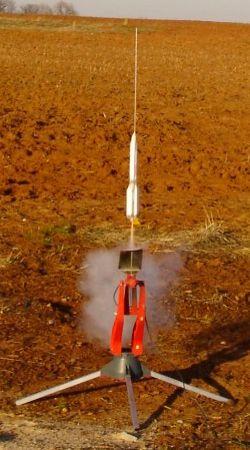 Flight 2: The second flight was a mirror image of the first. The bird proceeded to do two revolutions immediately after clearing the launch rod. After the second twist, the Proton straightened itself and flew a perfectly straight trajectory to ejection. I guess I didn't use enough or incorrectly loaded the wadding. The chute was scorched by the ejection and didn't unfurl completely. The landing was hard. The Proton bounced approximately one or two feet on impact. There is some minor skin damage to the paper and some more clay markings on the nose. If I had been flying on a grassy field, I'm sure it would have had some grass stains.
Flight 2: The second flight was a mirror image of the first. The bird proceeded to do two revolutions immediately after clearing the launch rod. After the second twist, the Proton straightened itself and flew a perfectly straight trajectory to ejection. I guess I didn't use enough or incorrectly loaded the wadding. The chute was scorched by the ejection and didn't unfurl completely. The landing was hard. The Proton bounced approximately one or two feet on impact. There is some minor skin damage to the paper and some more clay markings on the nose. If I had been flying on a grassy field, I'm sure it would have had some grass stains.
I flew the Proton in a steady wind. I knew this would not be good for this bird, but my go fever said fly anyway. With calm winds and a longer launch rod, the stability of this rocket should not be a problem. The hard clay was a less than ideal recovery surface so now my Proton has a few extra markings after two flights.
Summary:
This was a fun, inexpensive, project. I didn't have to order a single part or have to wait for a kit to arrive in the mail. It didn't take a long time to build and I was rewarded with a unique looking scale model. I flew it aggressively knowing that if it failed, I could always build another. I am hooked on paper models and plan to build more in the future.
 |
 |
 |
 |
Keoki Gray (June 22, 2014)
Great model and review--thanks!
For those looking for this model, or others like it, the Lower Hudson Valley E-gift Shop site has a bunch of great paper models that may be adapted for flight, including a Proton. The right search engine will get you there in no time. Happy model building and flying all y'all!